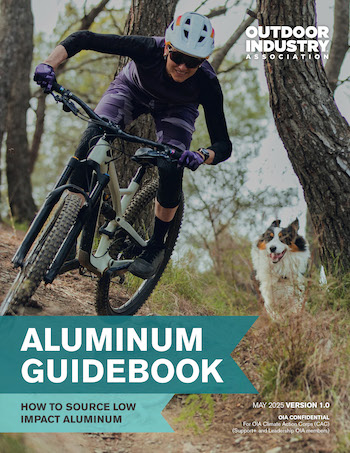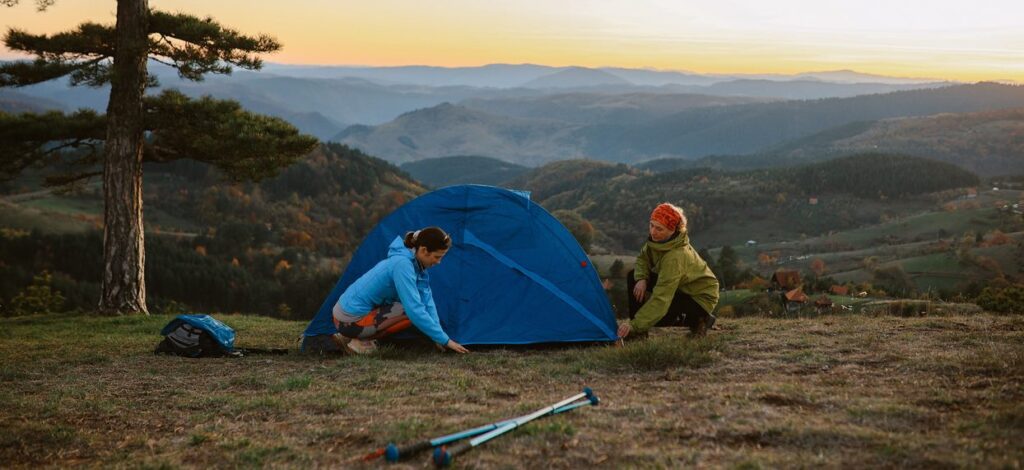 Introducing OIA’s Aluminum Guidebook
Introducing OIA’s Aluminum Guidebook
Aluminum is one of the most widely used materials in the outdoor industry, valued for its strength, lightweight properties, affordability, and availability. However, it is also a significant contributor to many brands’ environmental footprints. In response to OIA members seeking guidance on reducing their aluminum-related greenhouse gas (GHG) emissions, we created the Aluminum Guidebook. While aluminum is a common material in outdoor products, the industry lacks clear guidance on practical environmental impact strategies for this material. The guidebook fills that gap by outlining actionable pathways to lower the environmental impact of aluminum without compromising product performance.
“The production of aluminum in our supply chain is one of the biggest sources of carbon emissions. The industry and SRAM have made progress, but we have a lot of work left to do. Creating this guidebook was a great opportunity to share our experience, learn from others on this journey, and will help SRAM formalize our work and educate our teams on how we can adopt more low-carbon aluminum,” said Nick Myhre, Sustainability and Strategy with SRAM.
Aluminum Guidebook Purpose
The Aluminum Guidebook helps sustainability, sourcing, materials, and product teams in outdoor companies of any size integrate more environmentally friendly aluminum into their products.
Co-created by OIA’s Aluminum Task Force, made up of brands across categories such as camp, cycling, ski and snow, footwear, drinkware, and accessories, the guide brings together resources from brand leaders, aluminum organizations (e.g., Aluminum Stewardship Initiative, International Aluminum Institute), and learnings from direct conversations and site visits with manufacturing partners. These members worked to build a comprehensive guidebook for all outdoor brands to reduce their emissions.
We encourage members to use the guidebook to establish internal processes for sourcing low-impact aluminum and to engage their supply chain partners in driving real, measurable progress together. The guidebook is designed to help sustainability and supply chain teams build stronger internal alignment by creating a shared language and an understanding of why low-carbon aluminum matters and how to source it.
OIA acknowledges that aluminum production also presents other sustainability challenges, including ecosystem disturbances, air and groundwater pollution, and water consumption. While these issues are important, the guidebook centers specifically on reducing GHG emissions.
“As a mid-sized brand, Peak Design is very familiar with the challenges of sourcing low-carbon aluminum and the complexities of the aluminum supply chain. For over six years, Peak Design has been expanding our use of lower-impact aluminum, but it became clear that we couldn’t fully succeed alone. By engaging with OIA, we’ve helped align brands around a shared understanding of the challenges and built a unified, actionable, recommended approach to low-carbon sourcing. The guidebook bridges common disconnects between sourcing, sustainability, and leadership teams and offers a clear framework for decision-making. This work directly supports our own goals while helping raise the bar for the outdoor industry. There is a long way to go, but we have a clearer roadmap than ever before,” said Oliver Ambros, Supply Chain Sustainability Manager at Peak Design.
Guidebook Key Points:
- Low-impact aluminum = aluminum produced with a lower carbon footprint
- There are two main ways to reduce carbon emissions in aluminum production:
- Low-carbon energy, such as hydro or other renewable power sources
- Recycled content materials, either pre– or post-consumer
- Lower emissions ≠ worse performance
- Strong relationships with internal teams and supply chain partners are critical for increased impact.
Lower Emissions ≠ Worse Performance
Low-impact aluminum (produced using recycled content and/or low-carbon energy sources) is a key driver for reducing greenhouse gas emissions and meeting climate targets. Shifting to low-impact aluminum does not mean sacrificing product performance. While the outdoor industry represents a small share of global aluminum demand, collaboration across our industry can help build a stronger, collective voice to advocate for low-carbon options.
Strong Relationships are Key to Impact
Building strong relationships is essential for impact—internally with product and design teams to align performance and sustainability goals, and across the value chain to better understand sourcing challenges and opportunities. Together, we can help accelerate the shift toward low-impact aluminum and a more sustainable industry.
Resources to Support Your Low-Impact Aluminum Journey
- Join OIA to gain full access to the Aluminum Guidebook
“OIA members created the Aluminum Guidebook to help our industry tackle a shared challenge: driving meaningful emissions reductions in a complex and competitive aluminum supply chain. It can be difficult for individual brands to influence suppliers, especially when competing with larger industries like automotive or aerospace, but when our members come together, they become a powerful collective voice for change. This guidebook is a tool to harness that strength and support coordinated, actionable progress across the industry,” said Julie Brown, OIA Sustainable Business Innovation Director.





